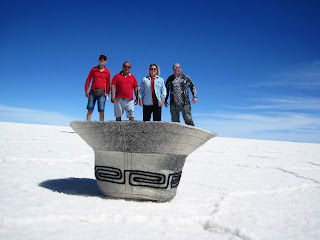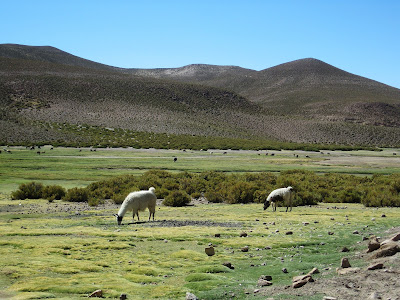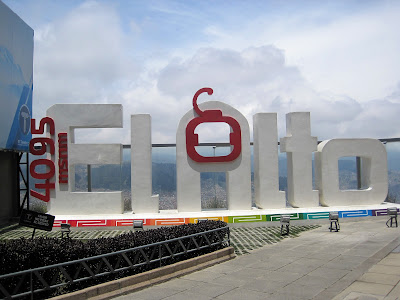At an altitude of over 3,800m/ 12,500ft, the lake is the world's highest navigable body of water and is 190kms/118miles long by 80kms/50 miles wide and is said to be the birthplace of the Incas. It is also incredibly deep with a maximum depth of 284m/932ft. We took a boat out to the "Floating islands", man-made islands made from thick buoyant reeds by the Uros people. According to legend, the Uru people migrated from the Amazon to the lake area but were oppressed by the local population so built the reed islands so they could be moved into deep water for greater safety.
From Copacabana, we headed to La Paz. The main highway crosses the Strait of Tiquina, separating the big lake from the little lake. The only way across is by ferry which are more like barges. Busses and trucks cross this way too, although the barge we were on needed a bit more attention
some trick shots our driver took
The flats
Incahuasi - an 'island' in the middle of the salt flats where the strange cacti grow
Day 2 on the road again into Eduardo Avaroa Andean Fauna National Reserve
Arbol de Piedra, or "stone tree"
No wonder we were out of breath
Day 3 - up at 4am to set out for the geysers at sunrise
Lago Blanco
a bear and a dog?
At the end of the day we caught the overnight bus from Uyuni back to La Paz. Again, we had sleeper seats but the bus stopped a few times before midnight, and the driver was heard banging bits of metal before setting off again. The last time was fatal and the bus had broken down. To be fair to the company, two other buses turned up before the lights went on and woke every one else up and we found seats and carried on sleeping until we arrived in La Paz on time at 6am. We were lucky enough to be able to check into our Airbnb apartment at 8am, have a nice hot shower and get a few hours sleep before exploring the city again for a few days. This time, the 3,650m altitude didn't seem much of a problem as it had been before.
The next day we decided to ride the various cable car lines and see the city from above
Not sure where La Paz finished and El Alto began
It was an interesting drive out of La Paz as the steep gradient and altitude meant the car wouldn't do more than 15kph and Mark was on tenterhooks incase it stalled, but we made it out with no problems.
On our way to Chile we passed a number of volcanoes and taking photos out of the window on the move is always interesting. In fact, I couldn't have framed this shot better if I had tried.
Now we are in Chile and the adventure continues...





































No comments:
Post a Comment